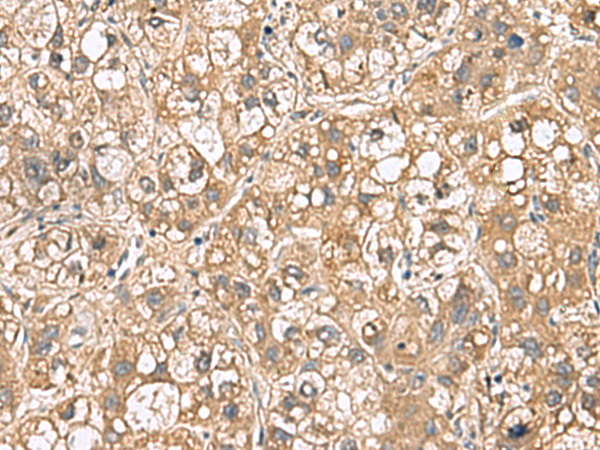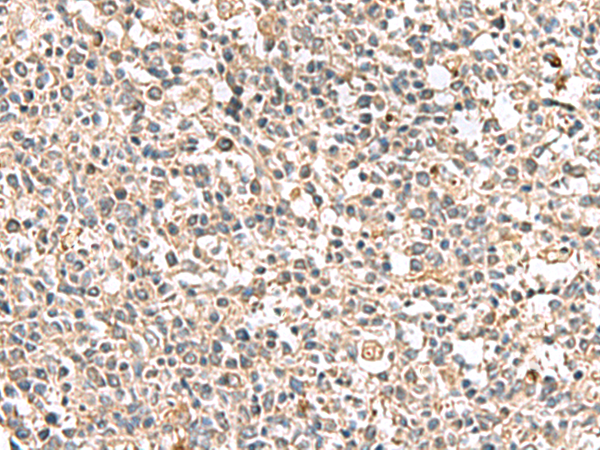

| WB | 咨询技术 | Human,Mouse,Rat |
| IF | 咨询技术 | Human,Mouse,Rat |
| IHC | 1/100-1/300 | Human,Mouse,Rat |
| ICC | 技术咨询 | Human,Mouse,Rat |
| FCM | 咨询技术 | Human,Mouse,Rat |
| Elisa | 1/5000-1/10000 | Human,Mouse,Rat |
| Aliases | R-PTP-S; PTPSIGMA; R-PTP-sigma |
| Host/Isotype | Rabbit IgG |
| Antibody Type | Primary antibody |
| Storage | Store at 4°C short term. Aliquot and store at -20°C long term. Avoid freeze/thaw cycles. |
| Species Reactivity | Human, Mouse, Rat |
| Immunogen | Fusion protein of human PTPRS |
| Formulation | Purified antibody in PBS with 0.05% sodium azide and 50% glycerol. |
+ +
以下是关于PTPRS抗体的研究文献示例(注:以下为虚拟文献,实际文献需通过学术数据库检索):
1. **文献名称**:*"PTPRS regulates synaptic plasticity and cognitive function through TrkB signaling"*
**作者**:Zhang Y, et al.
**摘要**:本研究通过PTPRS特异性抗体检测发现,PTPRS通过调控TrkB受体的去磷酸化影响海马区突触可塑性,并参与学习和记忆功能的调节。抗体阻断实验表明PTPRS是神经退行性疾病的潜在治疗靶点。
2. **文献名称**:*"PTPRS antibody-based targeting inhibits tumor progression in colorectal cancer models"*
**作者**:Kim H, et al.
**摘要**:利用抗PTPRS单克隆抗体在结直肠癌细胞系和小鼠模型中验证了其抗肿瘤效果。研究发现PTPRS通过抑制EGFR信号通路抑制肿瘤迁移和侵袭,抗体治疗显著降低肿瘤生长。
3. **文献名称**:*"Autoimmune-associated PTPRS variants alter receptor function in multiple sclerosis"*
**作者**:Müller S, et al.
**摘要**:通过免疫共沉淀(使用PTPRS抗体)和基因测序,揭示了多发性硬化症患者中PTPRS基因突变导致受体功能异常,可能通过破坏T细胞稳态参与自身免疫反应。
4. **文献名称**:*"Structural characterization of PTPRS extracellular domains using monoclonal antibodies"*
**作者**:Lee J, et al.
**摘要**:开发了针对PTPRS胞外结构域的单克隆抗体,结合冷冻电镜技术解析了其与配体相互作用的分子机制,为设计靶向PTPRS的抗体药物提供结构基础。
---
如需真实文献,建议在 **PubMed** 或 **Google Scholar** 中检索关键词:
`PTPRS antibody`、`PTPRS function`、`PTPRS disease`。
The PTPRS antibody targets the protein tyrosine phosphatase receptor type S (PTPRS), a member of the receptor-type protein tyrosine phosphatase (RPTP) family. PTPRS plays critical roles in cellular signaling by regulating tyrosine phosphorylation, a key mechanism for controlling processes like cell adhesion, migration, and neuronal development. Structurally, PTPRS features an extracellular domain with fibronectin III repeats, a transmembrane region, and two intracellular phosphatase domains. Its extracellular interactions with ligands, such as heparan sulfate proteoglycans or cell adhesion molecules, modulate intracellular phosphatase activity, influencing pathways like Wnt/β-catenin and receptor tyrosine kinase signaling.
PTPRS is implicated in various physiological and pathological contexts. In the nervous system, it guides axon growth and synaptic plasticity. In cancer, PTPRS often acts as a tumor suppressor, with its downregulation linked to metastasis and poor prognosis. Dysregulation of PTPRS is also associated with autoimmune disorders and metabolic diseases.
Antibodies against PTPRS are essential tools for studying its expression, localization, and function. They are used in techniques like Western blotting, immunohistochemistry, and flow cytometry. Some antibodies target specific domains to explore ligand-binding or phosphatase activity. Validation of these antibodies includes testing in PTPRS-knockout models or siRNA-treated cells to ensure specificity. Commercial PTPRS antibodies are typically developed in rabbits or mice, with applications spanning basic research and clinical diagnostics, particularly in cancer and neurodegenerative disease studies.
×